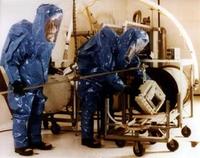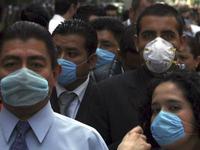-
Government considers testing anthrax vaccine on children

The U.S. government is considering testing its anthrax vaccine on children to determine if it has any potential side effects; so far the government’s anthrax vaccine has only been tested on adults and members of the National Biodefense Science Board argued that there had been no tests to determine the effectiveness of the vaccine on children; opponents of the suggestion have sharply criticized it on the grounds that it is unethical to test a vaccine on children especially if there is no immediate threat; proponents of testing the vaccine acknowledged the criticism, but maintained that it was critical to ensure the safety of the vaccine on children in the event that it had to be administered; the board is set to meet again on Friday to vote on its controversial recommendation
-
-
11,000 California parents refuse basic vaccinations for their children

Even with the massive whooping cough outbreak last year in California that sickened more than 9,100 people and killed ten babies, over 11,000 hesitant parents chose not to vaccinate their children against the infectious disease; with record numbers of children going unvaccinated, there have been an increasing number of outbreaks of highly infectious diseases like measles and whooping cough
-
-
HHS proposes new rule regarding toxins
The U.S. Department of Health and Human Services (HHS) has issued a proposed rule regarding the biennial review of the possession, use, and transfer of select agents and toxins, according to Secretary Kathleen Sebelius
-
-
Anthrax vaccine contract worth up to $1.25 billion over five years
Emergent BioSolutions has been awarded a contract to supply the U.S. government with FDA-licensed anthrax vaccine; the 5-year contract a has a total value of up to $1.25 billion; the first 8.5 million doses will be delivered before the end of the year
-
-
Report: anthrax antibiotic should be stockpiled locally
A new report describes a plan for the United States to be better prepared in the event of a bioterrorist attack using anthrax; the report recommends that public health officials in high-risk areas should consider stockpile anthrax antibiotics in local locations to make it easier to dispense quickly to an area of need, rather than continuing to use the single national stockpile
-
-
Real-time disease monitoring can help improve diagnoses
Discovering epidemics or knowing when one is brewing is particularly difficult at the local level as doctors lack a broader perspective of what is occurring; to help provide local doctors with better information that could help stem the spread of infectious diseases, public health officials are pushing for the creation of a real-time national disease monitoring system
-
-
Japanese attenuated smallpox vaccine shows promise in U.S. trial
An attenuated smallpox vaccine that was developed in Japan in the 1970s compared well with a conventional smallpox vaccine in a phase 1-2 clinical trial in the United States
-
-
Mapping the spread of drug-resistant influenza

The movie “Contagion” is not based on real events, but it is not science fiction, either: certain strains of influenza are becoming resistant to common treatments; a team of researchers map out how this phenomenon is happening globally
-
-
Budget cuts could hurt biodefense efforts

With lawmakers struggling to reduce spending and cut the deficit, funding for government programs aimed at thwarting biological threats could face severe budget cuts; while the budget for overall civilian biodefense increased by 17 percent, that number is deceiving as federal agencies consolidated and combined several key programs under larger budget line item headings
-
-
Biological weapons: U.S. must not repeat the failure of imagination
Joel McCleary, a biological weapons expert, is the chairman and co-founder of Q Global and the founder of PharmAthene; he argues that the U.S. government has not done enough to protect the nation against a biological attack, warns of the need for presidential leadership, and underscores the dangers of biological weapons
-
-
Scientists "domesticate" -- and disarm -- malaria parasite
Malaria is one of the Earth’s most notorious scourges, accounting for more than 250 million new cases — and one million deaths — each year, researchers have developed a novel technique to “tame” the malaria parasite by forcing it to depend on an external supply of a vital chemical; this could help to speed up drug development and provide the basis for the first effective vaccine against malaria
-
-
Lawmakers struggling to end critical medicine shortage
Critical shortages for medicines needed in treating life-threatening illnesses have lawmakers and public health officials scrambling to find solutions; this year alone, a record high of more than 180 drugs crucial for treating childhood leukemia, breast and colon cancer, infections, and other diseases have been declared in short supply
-
-
Overcoming dangerous antibiotic-resistant bacteria
Scientists have successfully reengineered an important antibiotic to kill the deadliest antibiotic-resistant bacteria; the compound could one day be used clinically to treat patients with life-threatening and highly resistant bacterial infections
-
-
Coriander oil tackles food poisoning and drug-resistant infections
Coriander oil has been shown to be toxic to a broad range of harmful bacteria; its use in foods and in clinical agents could prevent food-borne illnesses and even treat antibiotic-resistant infections, according to the authors of a study published in the Journal of Medical Microbiology
-
-
How did H1N1 become an pandemic?

The last century has seen two major pandemics caused by the H1N1 virus — the Spanish Flu in 1918 and 2009’s Swine Flu scare, which had thousands travelling with surgical masks and clamoring for vaccination; scientists, however, did not know what distinguished the Swine Flu from ordinary influenza in pigs or seasonal outbreaks in humans, giving it the power to travel extensively and infect large populations; until now
-
- All
- Regional
- Water
- Biometrics
- Borders/Immig
- Business
- Cybersecurity
- Detection
- Disasters
- Government
- Infrastructure
- International
- Public health
- Public Safety
- Communication interoperabillity
- Emergency services
- Emergency medical services
- Fire
- First response
- IEDs
- Law Enforcement
- Law Enforcement Technology
- Military technology
- Nonlethal weapons
- Nuclear weapons
- Personal protection equipment
- Police
- Notification /alert systems
- Situational awareness
- Weapons systems
- Sci-Tech
- Sector Reports
- Surveillance
- Transportation
Advertising & Marketing: advertise@newswirepubs.com
Editorial: editor@newswirepubs.com
General: info@newswirepubs.com
2010-2011 © News Wire Publications, LLC News Wire Publications, LLC
220 Old Country Road | Suite 200 | Mineola | New York | 11501
Permissions and Policies
Editorial: editor@newswirepubs.com
General: info@newswirepubs.com
2010-2011 © News Wire Publications, LLC News Wire Publications, LLC
220 Old Country Road | Suite 200 | Mineola | New York | 11501
Permissions and Policies
